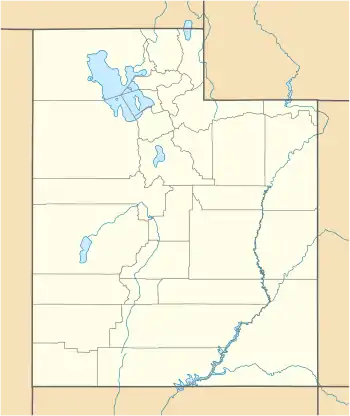Sandy Historic District
The Sandy Historic District is a Historic District in Sandy, Utah that covers most of the city's pre-suburbanization extent. It is essentially the area east of State Street, west of 700 East north of 9000 South, and south of Pioneer Avenue (8530 South; near the northern boundary of the city of Sandy). About half of the National Register of Historic Places listings in Salt Lake County outside of Salt Lake City are in Sandy, and the large majority of those are within the Historic District.[2]
Sandy Historic District | |
.jpg.webp) Jensen Kuhre store in historic district | |
 | |
| Location | Roughly bounded by State St. 9000 South, 700 East and Pioneer Ave., Sandy, Utah |
|---|---|
| Coordinates | 40°35′34″N 111°52′51″W |
| Area | 266.3 acres (1.078 km2) |
| Built | 1875 |
| Architect | multiple |
| Architectural style | Late Victorian, Colonial Revival, et al. |
| MPS | Sandy City MPS |
| NRHP reference No. | 07000084[1] |
| Added to NRHP | April 20, 2007 |
The district included 51 properties which were already listed in the National Register, plus 266 more contributing buildings, and 223 non-contributing buildings.[2] The district includes the NRHP-listed Jensen-Clark House, at 42 E. Main St.
History
Sandy was initially an agricultural settlement, but then became dominated by mining and smelting for a short time. When major smelting operations moved north to Murray and Midvale, the town was free from development pressures until suburbanization reached the area in the 1970s, by which time developers had almost totally lost interest in infill development; the Historic District thus has experienced very little large-scale redevelopment for a long time (though many individual houses have been added or rebuilt).
A smelter (now represented only by a historic monument) previously operated just south of the historic district, near State Street. A large cemetery is east of that, next to 700 East. A museum of Sandy's history occupies a small building just south of Sandy's Main Street, facing the rail main line now used by TRAX. The Salt Lake and Alta Railroad previously split from that main line just north of the district before curving through the northern parts of the district on its way to Granite and Alta.
Transportation
The street grid in the area has much smaller blocks than those in other parts of the county that followed Salt Lake City's layout decisions. Sandy also has its own Main Street (at 8720 South in the county's now-unified addressing system) that runs east to west rather than north to south like the county's most prominent Main Street. The street runs from a few blocks west of State Street to the steps of Sandy Elementary School, which is within the historic district, and passes in front of various historic buildings.
As was once very common in early Great Basin settlements, irrigation water flows in street-side gutters in some places. The East Jordan Canal, a much larger canal carrying water from the Jordan River north toward Salt Lake City, also passes through the center of the district.
The district is served by the UTA TRAX light rail system's Blue Line at Historic Sandy station south of Main Street and a few blocks east of State Street.
References
- "National Register Information System". National Register of Historic Places. National Park Service. November 2, 2013.
- Beatrice Lufkin (November 30, 2006). "National Register of Historic Places Registration: Sandy Historic District". National Park Service. Retrieved June 19, 2019. Includes map. With accompanying 42 photos from 2006
| Wikimedia Commons has media related to Sandy Historic District. |